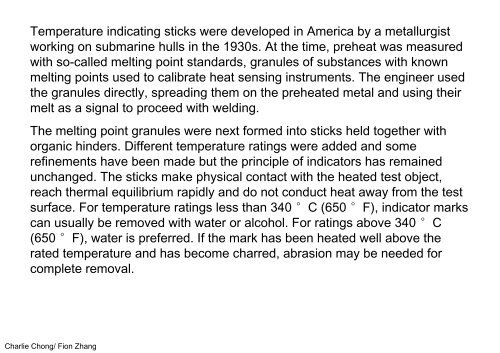ASNT Level III- Visual & Optical Testing
My Level III Self Study Notes Reading 4 Section 4B
My Level III Self Study Notes Reading 4 Section 4B
You also want an ePaper? Increase the reach of your titles
YUMPU automatically turns print PDFs into web optimized ePapers that Google loves.
Temperature indicating sticks were developed in America by a metallurgist<br />
working on submarine hulls in the 1930s. At the time, preheat was measured<br />
with so-called melting point standards, granules of substances with known<br />
melting points used to calibrate heat sensing instruments. The engineer used<br />
the granules directly, spreading them on the preheated metal and using their<br />
melt as a signal to proceed with welding.<br />
The melting point granules were next formed into sticks held together with<br />
organic hinders. Different temperature ratings were added and some<br />
refinements have been made but the principle of indicators has remained<br />
unchanged. The sticks make physical contact with the heated test object,<br />
reach thermal equilibrium rapidly and do not conduct heat away from the test<br />
surface. For temperature ratings less than 340 °C (650 °F), indicator marks<br />
can usually be removed with water or alcohol. For ratings above 340 °C<br />
(650 °F), water is preferred. If the mark has been heated well above the<br />
rated temperature and has become charred, abrasion may be needed for<br />
complete removal.<br />
Charlie Chong/ Fion Zhang


















